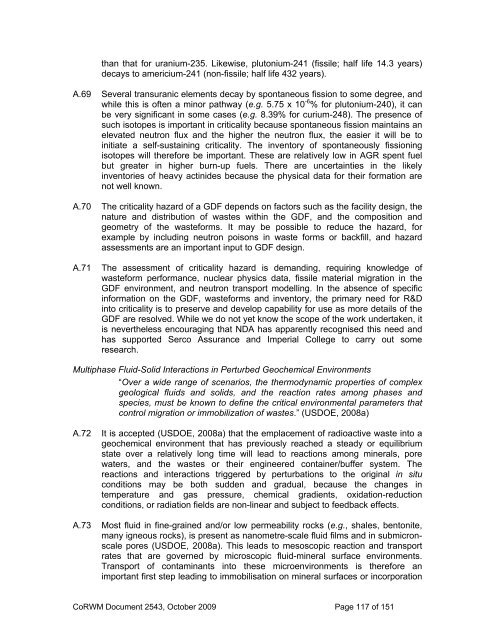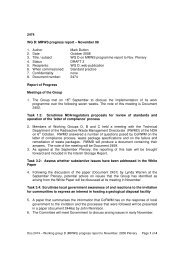2009 Report to Government on National Research and
2009 Report to Government on National Research and
2009 Report to Government on National Research and
- TAGS
- corwm.decc.gov.uk
You also want an ePaper? Increase the reach of your titles
YUMPU automatically turns print PDFs into web optimized ePapers that Google loves.
than that for uranium-235. Likewise, plu<str<strong>on</strong>g>to</str<strong>on</strong>g>nium-241 (fissile; half life 14.3 years)<br />
decays <str<strong>on</strong>g>to</str<strong>on</strong>g> americium-241 (n<strong>on</strong>-fissile; half life 432 years).<br />
A.69 Several transuranic elements decay by sp<strong>on</strong>taneous fissi<strong>on</strong> <str<strong>on</strong>g>to</str<strong>on</strong>g> some degree, <strong>and</strong><br />
while this is often a minor pathway (e.g. 5.75 x 10 -6 % for plu<str<strong>on</strong>g>to</str<strong>on</strong>g>nium-240), it can<br />
be very significant in some cases (e.g. 8.39% for curium-248). The presence of<br />
such iso<str<strong>on</strong>g>to</str<strong>on</strong>g>pes is important in criticality because sp<strong>on</strong>taneous fissi<strong>on</strong> maintains an<br />
elevated neutr<strong>on</strong> flux <strong>and</strong> the higher the neutr<strong>on</strong> flux, the easier it will be <str<strong>on</strong>g>to</str<strong>on</strong>g><br />
initiate a self-sustaining criticality. The inven<str<strong>on</strong>g>to</str<strong>on</strong>g>ry of sp<strong>on</strong>taneously fissi<strong>on</strong>ing<br />
iso<str<strong>on</strong>g>to</str<strong>on</strong>g>pes will therefore be important. These are relatively low in AGR spent fuel<br />
but greater in higher burn-up fuels. There are uncertainties in the likely<br />
inven<str<strong>on</strong>g>to</str<strong>on</strong>g>ries of heavy actinides because the physical data for their formati<strong>on</strong> are<br />
not well known.<br />
A.70 The criticality hazard of a GDF depends <strong>on</strong> fac<str<strong>on</strong>g>to</str<strong>on</strong>g>rs such as the facility design, the<br />
nature <strong>and</strong> distributi<strong>on</strong> of wastes within the GDF, <strong>and</strong> the compositi<strong>on</strong> <strong>and</strong><br />
geometry of the wasteforms. It may be possible <str<strong>on</strong>g>to</str<strong>on</strong>g> reduce the hazard, for<br />
example by including neutr<strong>on</strong> pois<strong>on</strong>s in waste forms or backfill, <strong>and</strong> hazard<br />
assessments are an important input <str<strong>on</strong>g>to</str<strong>on</strong>g> GDF design.<br />
A.71 The assessment of criticality hazard is dem<strong>and</strong>ing, requiring knowledge of<br />
wasteform performance, nuclear physics data, fissile material migrati<strong>on</strong> in the<br />
GDF envir<strong>on</strong>ment, <strong>and</strong> neutr<strong>on</strong> transport modelling. In the absence of specific<br />
informati<strong>on</strong> <strong>on</strong> the GDF, wasteforms <strong>and</strong> inven<str<strong>on</strong>g>to</str<strong>on</strong>g>ry, the primary need for R&D<br />
in<str<strong>on</strong>g>to</str<strong>on</strong>g> criticality is <str<strong>on</strong>g>to</str<strong>on</strong>g> preserve <strong>and</strong> develop capability for use as more details of the<br />
GDF are resolved. While we do not yet know the scope of the work undertaken, it<br />
is nevertheless encouraging that NDA has apparently recognised this need <strong>and</strong><br />
has supported Serco Assurance <strong>and</strong> Imperial College <str<strong>on</strong>g>to</str<strong>on</strong>g> carry out some<br />
research.<br />
Multiphase Fluid-Solid Interacti<strong>on</strong>s in Perturbed Geochemical Envir<strong>on</strong>ments<br />
“Over a wide range of scenarios, the thermodynamic properties of complex<br />
geological fluids <strong>and</strong> solids, <strong>and</strong> the reacti<strong>on</strong> rates am<strong>on</strong>g phases <strong>and</strong><br />
species, must be known <str<strong>on</strong>g>to</str<strong>on</strong>g> define the critical envir<strong>on</strong>mental parameters that<br />
c<strong>on</strong>trol migrati<strong>on</strong> or immobilizati<strong>on</strong> of wastes.” (USDOE, 2008a)<br />
A.72 It is accepted (USDOE, 2008a) that the emplacement of radioactive waste in<str<strong>on</strong>g>to</str<strong>on</strong>g> a<br />
geochemical envir<strong>on</strong>ment that has previously reached a steady or equilibrium<br />
state over a relatively l<strong>on</strong>g time will lead <str<strong>on</strong>g>to</str<strong>on</strong>g> reacti<strong>on</strong>s am<strong>on</strong>g minerals, pore<br />
waters, <strong>and</strong> the wastes or their engineered c<strong>on</strong>tainer/buffer system. The<br />
reacti<strong>on</strong>s <strong>and</strong> interacti<strong>on</strong>s triggered by perturbati<strong>on</strong>s <str<strong>on</strong>g>to</str<strong>on</strong>g> the original in situ<br />
c<strong>on</strong>diti<strong>on</strong>s may be both sudden <strong>and</strong> gradual, because the changes in<br />
temperature <strong>and</strong> gas pressure, chemical gradients, oxidati<strong>on</strong>-reducti<strong>on</strong><br />
c<strong>on</strong>diti<strong>on</strong>s, or radiati<strong>on</strong> fields are n<strong>on</strong>-linear <strong>and</strong> subject <str<strong>on</strong>g>to</str<strong>on</strong>g> feedback effects.<br />
A.73 Most fluid in fine-grained <strong>and</strong>/or low permeability rocks (e.g., shales, ben<str<strong>on</strong>g>to</str<strong>on</strong>g>nite,<br />
many igneous rocks), is present as nanometre-scale fluid films <strong>and</strong> in submicr<strong>on</strong>scale<br />
pores (USDOE, 2008a). This leads <str<strong>on</strong>g>to</str<strong>on</strong>g> mesoscopic reacti<strong>on</strong> <strong>and</strong> transport<br />
rates that are governed by microscopic fluid-mineral surface envir<strong>on</strong>ments.<br />
Transport of c<strong>on</strong>taminants in<str<strong>on</strong>g>to</str<strong>on</strong>g> these microenvir<strong>on</strong>ments is therefore an<br />
important first step leading <str<strong>on</strong>g>to</str<strong>on</strong>g> immobilisati<strong>on</strong> <strong>on</strong> mineral surfaces or incorporati<strong>on</strong><br />
CoRWM Document 2543, Oc<str<strong>on</strong>g>to</str<strong>on</strong>g>ber <str<strong>on</strong>g>2009</str<strong>on</strong>g> Page 117 of 151



